Easter in Greece is no ordinary holiday — it’s a homecoming, a festival of light, sound, and scent that sweeps across the country in waves of incense, roasted lamb, fireworks, and blooming wildflowers. While the midnight Resurrection (“Anastasi”) Mass and the tapping of red-dyed eggs (“tsougrisma”) are well known even to casual visitors, the deeper spirit of Greek Easter reveals itself through lesser-known rituals passed down in mountain villages, coastal towns, and sun-drenched islands.
If you’ve ever thought about visiting Greece in the spring, Easter is the time to come — before the summer crowds arrive, when poppies blaze crimson through ancient olive groves and something celebratory (and almost always delicious) is unfolding in every village square.
Join us as we journey into some of Greece’s most endearing and unexpected Easter traditions — the kind that rarely appear in guidebooks, yet offer a deeper, more intimate connection to local life. From airborne pots and handmade lanterns to edible Lazaruses and small-town rocket wars, these regional customs don’t just mark the season — they bring it vividly to life.


© Shutterstock
Lazarakia and Lazarines
On the Saturday before Palm Sunday — known in Greece as “Lazarus Saturday” — the air fills with the heady aroma of cinnamon, cloves, and rising dough. Families across the country gather to bake “Lazarakia” — small, sweet loaves shaped like the mummified figure of St. Lazarus, his arms folded across his chest like a shrouded body. These gently spiced bread men commemorate the miracle of Jesus raising Lazarus from the dead, marking the quiet turn from Lent to Holy Week (“Megali Evdomada”).
Young children often join in the baking, decorating each loaf with clove eyes and carefully folding the dough to create cloth-like folds across the body. Unlike the buttery, egg-rich “tsoureki” baked later in the week, Lazarakia are Lenten — made without eggs or dairy, in keeping with fasting traditions.
In villages across northern Greece — particularly in the regions of Serres, Imathia, and Kozani — the day is also marked by a beautifully preserved folk tradition. Groups of young girls known as “Lazarines,” dressed in ornately embroidered costumes, go from house to house singing “ta kalanta tou Lazarou” — Lazarus carols — while carrying flower-filled baskets and small effigies of the saint. In return, they’re given unpainted eggs (to be dyed red on Holy Thursday), as well as nuts, sweets, and money.

© Shutterstock
The Sacred Washing of the Feet – Patmos
At noon on Holy Thursday, the Dodecanese island of Patmos hosts one of the most moving and symbolic rituals of the Orthodox Easter calendar: the Holy Niptiras — the sacred washing of the feet. Rooted in the Gospel of St. John and echoing Christ’s humility at the Last Supper, the ceremony re-enacts the moment when Jesus washed the feet of his Twelve Disciples.
The ritual begins after the Divine Liturgy at the Monastery of St. John the Theologian, the island’s spiritual heart. From there, a solemn procession makes its way through the flower-strewn streets of Hora, Patmos’s main town. At its head is an icon of Christ the Bridegroom (“o Nymphios”), carried with reverence by two monks, followed by the abbot, priests, monks, and gathered townspeople.
When the procession reaches Xanthos Square, a large, flower-decked platform awaits. At its center stand twelve chairs arranged for the priests, a silver basin of water, a table prepared for ritual, and a central throne for the abbot. As a reading from the Gospel of John unfolds, recounting the Last Supper, the abbot — in the role of Christ — rises to wash the feet of the twelve priests, each representing an Apostle.
Surrounded by the scent of spring blooms and the steady cadence of sacred chant, the ritual offers a rare moment of public intimacy and spiritual reflection — a quiet echo of a timeless act of grace. For our guide to Easter on Patmos, click here.

© Shutterstock
Passion Plays in Paros
While solemn “Epitaphios” processions take place across Greece on Good Friday — commemorating the crucifixion, death, and burial of Christ — the island of Paros adds a theatrical dimension that is both moving and uniquely immersive. In villages like Marpissa, Aspro Horio, Marmara, and Prodromos, the Passion of Christ is re-enacted through a series of “living stations of the cross.” Scenes such as Judas’s betrayal, the Scourging at the Pillar, and Christ’s ascent to Golgotha are performed by local youth in costume, illuminated by the glow of torchlight.
As dusk falls, the narrow lanes and quiet squares of these Cycladic villages are transformed into open-air stages. Homes, courtyards, and gardens become settings for the unfolding drama, as the entire community gathers to watch and participate. The tradition runs especially deep in Marpissa, a hillside village just beyond Lefkes, near some of Paros’s most beloved beaches. Here, on the evening of Holy Thursday, the women of the village begin decorating the Epitaphios inside the Church of the Metamorphosis of our Savior Jesus Christ, working through the night in silence and prayer. Their efforts culminate in the Good Friday funerary procession, which winds through fifteen stations along the mountainous terrain — a custom that dates back to before the Second World War.
Then, on Easter Saturday morning, the atmosphere gently shifts. As a quiet prelude to the coming joy, young girls dressed as angels appear in doorways and the village squares, offering a vision of calm and hope — a soft breath of light before the firework-filled celebration of Easter night.
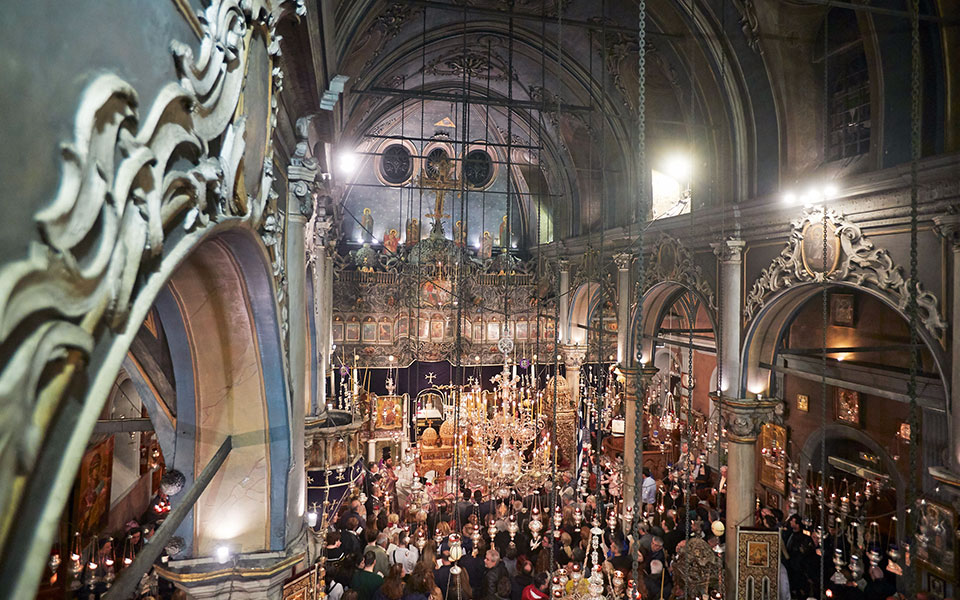
© Intime News
Sea Processions – Tinos and Syros
In the Cyclades, where Orthodox and Catholic communities have lived side by side for centuries, Good Friday unfolds not only in candlelit churches and public squares, but also at the edge of the sea — and sometimes in it.
On Tinos, the “Epitaphios” — the flower-covered bier representing the body of Christ — is carried not only through village streets, but directly into the Aegean. In places like Kionia and Spitalia Beach, near Hora, priests and parishioners wade solemnly into the water, hymns rising as waves lap at their ankles and petals scatter across the surface. Fishermen, sailors, and ferry crews join the procession, their boats sounding low salutes, their hands casting flowers into the surf. From the Church of Saint Nicholas, patron of seafarers, the Epitaphios makes its way to the beach at Makri Kladaki, where a funerary service is held for those lost at sea — a haunting, deeply felt tribute that turns ritual into remembrance.
Across the water, on the island of Syros — capital of the Cyclades — a similar spirit of coexistence defines the night. Catholic and Orthodox processions begin from separate churches: San George in Ano Syros and Evangelistria in Ermoupoli for the Catholic community; Agios Nikolaos, the Assumption of the Virgin Mary, and the Transfiguration of the Savior for the Orthodox. Slowly, the processions wind through the neoclassical streets of Ermoupoli, their paths illuminated by lanterns and reverent crowds.
At the heart of the town, in grand Miaouli Square, the processions converge. There, worshippers from both traditions gather for shared prayer — a quiet, powerful expression of unity that transcends doctrine and speaks to the enduring harmony of life on these islands.
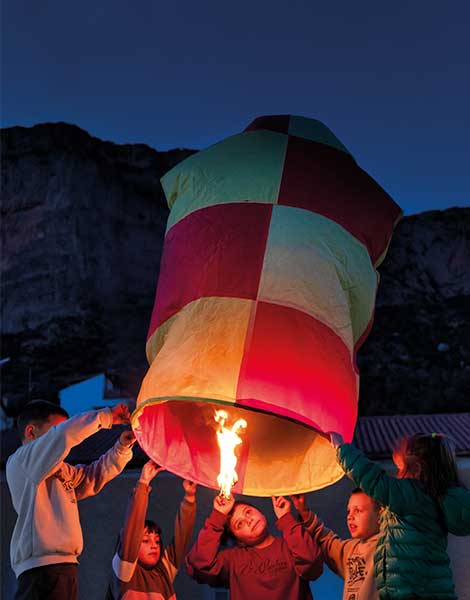
© Perikles Merakos
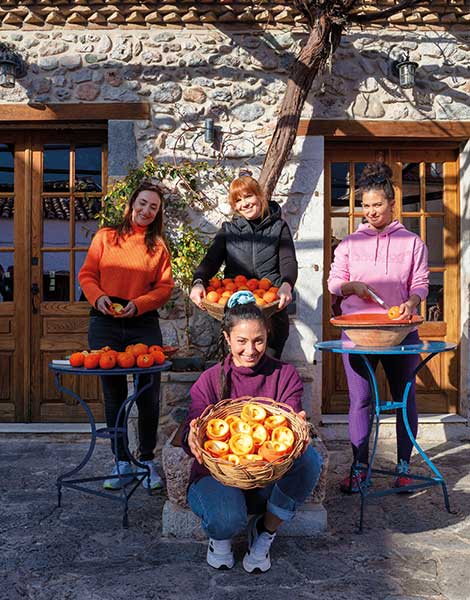
© Perikles Merakos
Hot Air Balloons and Bitter Orange Lanterns in Leonidio (Peloponnese)
Tucked between the striking Kokkinovrachos (“Red Cliff”) of the Parnon Mountains and the gentle curve of the Myrtoan Sea, the town of Leonidio welcomes Easter with one of the most enchanting sights in Greece: a sky ablaze with light. Part of the Tsakonia region in the eastern Peloponnese — known for its distinct cultural and linguistic identity — Leonidio transforms into a glowing canvas as midnight strikes and the Resurrection is proclaimed.
In that moment, hundreds of handmade hot air balloons are released into the night. These “aerostata” — delicate orbs of paper and flame — rise silently above rooftops and church towers, drifting over the Dafnonas Valley below in a slow, shimmering ascent. It’s a breathtaking sight, both communal and deeply symbolic.
The tradition is rooted in both craftsmanship and devotion. Each family or parish constructs their own balloon during Lent, using 100% cotton fabric for the “kollimara” — the gasoline-soaked cloth that gives the balloon its lift. The designs vary: some plain, others hand-painted in vibrant colors, but all made with care and anticipation. On Easter night, they’re lit and launched together, turning the sky into a living tapestry of light and hope.
In recent years, Leonidio has introduced another luminous tradition. About 14 years ago, locals began crafting small lanterns from the region’s abundant bitter oranges. In the weeks leading up to Easter, groups of women gather to hollow out thousands of oranges, preserving the peels in freezers. On Good Friday, these natural lanterns are placed outside homes and shops, lighting the streets for the Epitaphios procession. As the flames flicker within, the air fills with the sweet, smoky scent of caramelizing citrus — a sensory memory that lingers long after the procession has passed.
Set against a backdrop of 19th-century stone mansions and steep canyon walls, Easter in Leonidio is a celebration like no other — luminous, local, and utterly unforgettable.
For more on the Easter traditions of Leonidio, click here.

© Shutterstock
Rocket Wars in Vrontados, Chios
After the floating lanterns of Leonidio and the sea-lit processions of Tinos, Easter takes a dramatic — and deafening — turn on the island of Chios. In the village of Vrontados, Easter Saturday night becomes a battleground of light and sound as two rival parishes engage in one of Greece’s most explosive traditions: the Rouketopolemos, or “Rocket War.”
As the midnight hymn rings out and “Christos Anesti!” echoes through the valley, tens of thousands of handmade rockets arc between the churches of Agios Markos and Panagia Erithiani — perched on opposing hills. Packed with gunpowder and launched from wooden racks, the fiery projectiles light up the night sky in a thunderous, smoky spectacle. The aim? To strike the opposing church’s bell tower.
The origins of the rouketopolemos are unclear. Some trace it to Ottoman times, when fireworks may have replaced banned cannons. Today, it’s a well-coordinated effort: locals spend months preparing the rockets and setting up elaborate launch rigs across the village.
It’s loud, chaotic, and not without risk — houses are boarded up, protective fencing goes up, and spectators are urged to keep a safe distance (and bring earplugs). But for the people of Vrontados, it’s more than a show: it’s tradition, identity, and craftsmanship wrapped in one fiery rivalry. And while scores are tallied, no one ever really agrees on the winner — which keeps the rockets flying year after year.
Unforgettable, unmissable — and absolutely not for the faint-hearted.
Click here for our guide to Easter on Chios.
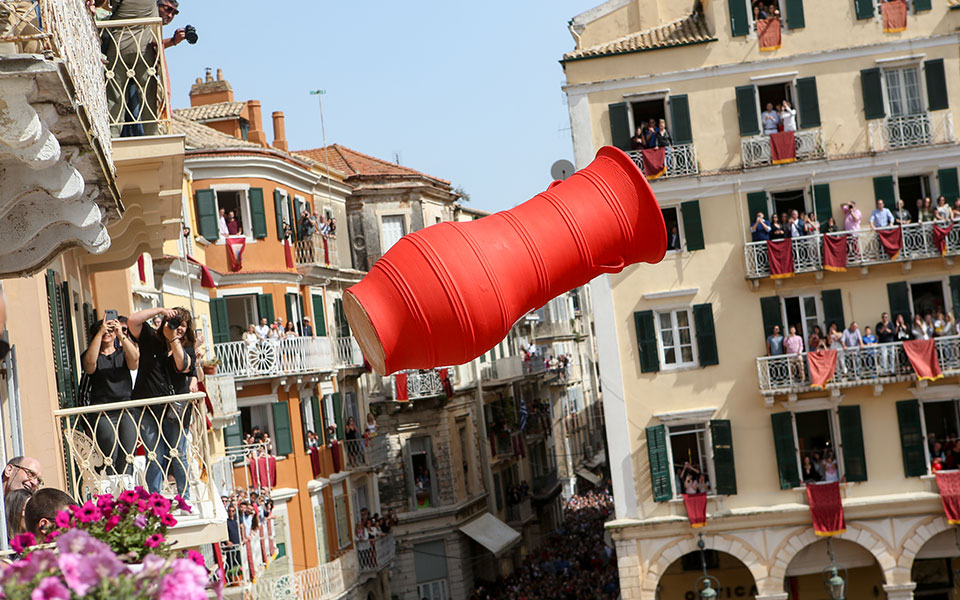
© Κatapodis Stamatis/INTIME NEWS
Pot Smashing on Corfu
On Holy Saturday morning, the genteel elegance of Corfu Town gives way to a joyful crash of chaos. As the first Resurrection bells ring from the Church of Aghios Spyridon, locals hurl giant terracotta pots — “botides” — from balconies onto the cobbled streets below.
Often filled with water for maximum effect, the pots shatter on impact to the cheers of gathered crowds. The streets of Spianada Square and the Liston promenade become a stage for this theatrical release — a symbolic breaking of old things and a bold welcome to the Resurrection.
The tradition’s roots are debated. Some say it dates to Venetian times, when old belongings were tossed out at New Year. Others believe it echoes ancient spring rites meant to awaken the earth. Today, it’s simply part of Easter in Corfu — a noisy, exhilarating ritual of renewal.
Balconies are draped in red cloth, brass bands march through the streets, and the air thrums with anticipation. Arrive early if you want a good view — and maybe duck for cover. After the smashing, it’s common to collect shards as lucky charms, carried home as keepsakes of a very Corfiot kind of joy.
For more information on what to see and do on Corfu at Easter, click here.
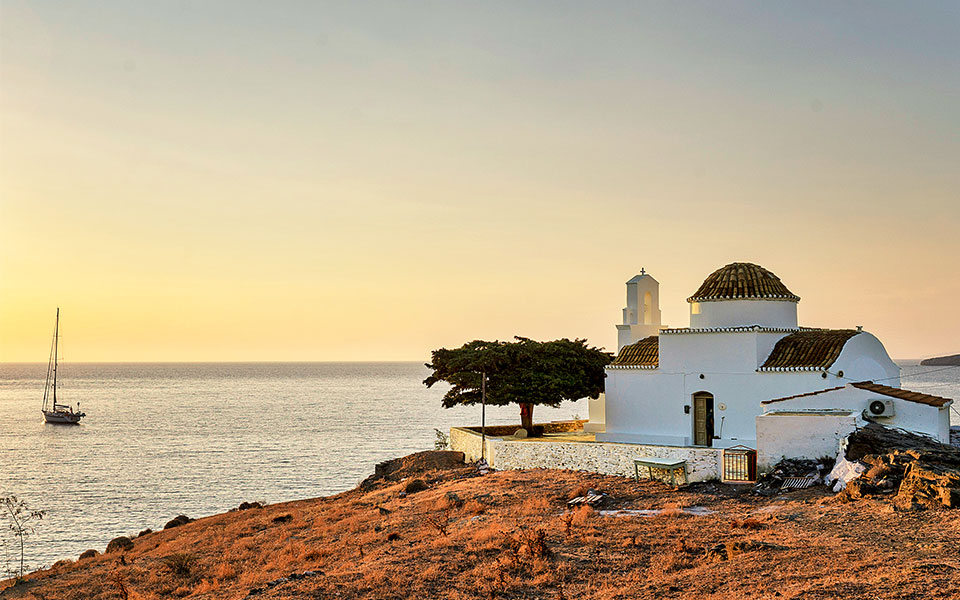
© Peirkles Merakos
Rituals of Renewal: Swings, Rain, and Bread
On the Cycladic islands of Kimolos, Kythnos, and Serifos, the tradition of the “Kounia” — or swing — comes alive during the Easter period, with variations from island to island. In Kimolos, it takes place on Easter Sunday; in Kythnos, on Monday; and in Serifos, on Tuesday.
In the village square, a large swing is hung from a central frame or tree, and young girls dressed in traditional attire take turns swinging. In some versions of the custom, couples ascend the swing and declare their intention to marry before the community — a public moment of joy, promise, and playfulness.
The tradition traces its roots to the ancient Anthesteria festival of Athens, held in honor of Dionysus, where young women swung in hammocks as a symbol of courtship and fertility. The feeling of flight, it was believed, would bring luck and invite new beginnings.
Far to the north, in the village of Kalyvia Limenaria on the island of Thassos, another ancient echo takes shape. On the third day of Easter, locals perform the “Rain, My April” dance — an ecstatic, rhythmic invocation for spring showers believed to have its roots in the Dionysian mysteries. The communal dance is followed by a rustic feast of meat and rice, simmered in vast cauldrons and shared by all — a ritual of nourishment, both literal and spiritual.
In the foothills of Mount Pangaion, in the village of Eleftheres, near Kavala, one of the oldest Easter customs still practiced is known as the “Mazidia.” On Easter Monday, a procession of icons is carried from the Byzantine church of Agios Taxiarchis to the chapel of Saints Raphael, Irene, and Nicholas. There, villagers hold the “Artoklasia” — the Blessing of the Five Loaves — a brief but powerful rite of thanksgiving, offering wine, oil, wheat, and bread as symbols of life’s essential gifts. The consecration is meant to secure divine favor for the growing season ahead. After the service, the icons are returned to the church, and the celebration spills into the village square, where dancing, music, and home-cooked food bring the day to a joyful close.
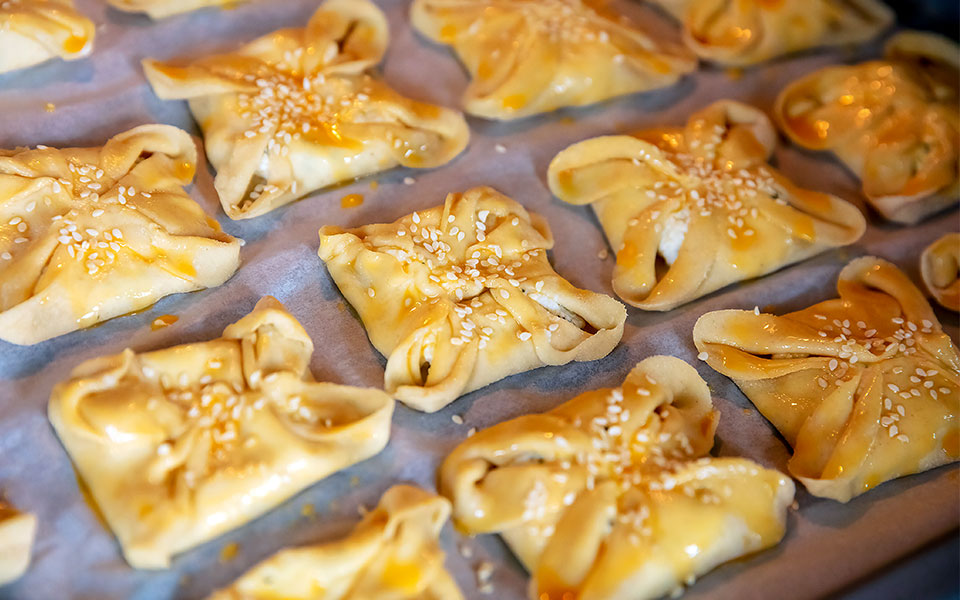
© Shutterstock
Regional Culinary Treats
Yes, there’s lamb on the spit. And yes, there’s “magiritsa” — the rich, restorative Easter soup made from lamb offal and greens, traditionally eaten after the midnight Resurrection service. But beyond these staples lies a sprawling, deeply regional feast of lesser-known Easter delicacies — each shaped by local terrain, seasonal ingredients, and generations of family tradition.
In the rugged mountains of Epirus, it’s “avgolemono” — a lemony egg soup that’s lighter and brighter than magiritsa, often made with goat or chicken. On the island of Astypalaia, saffron blooms across spring fields, and its golden threads are worked into vivid yellow biscuits baked during Holy Week — sweet and fragrant.
In the upland villages of Central Greece, you will come across “kokoretsi” — a rustic favorite of seasoned lamb offal wrapped in intestines, skewered, spiced, and roasted beside the Easter lamb.
Further south, in the stark beauty of the Mani Peninsula, Easter breads are dark and dense, heavy with cinnamon, clove, and orange peel, their crusts stamped with crosses or family initials. And in Crete, no Easter table is complete without “kalitsounia” — hand-shaped pies filled with local cheese or wild greens, sometimes sweetened with honey or scented with mint, their delicate folds echoing the rising spring sun.
These are not dishes you’ll often find on restaurant menus. Many are made at home, passed quietly between neighbors or sold from village bakeries for just a few days each year. If you’re in Greece during Easter, ask around. Follow the scent of anise and woodsmoke, wander through a local market, or accept an invitation to a stranger’s table. You might just find yourself tasting something unforgettable — a dish you’ve never heard of, made by someone’s grandmother, served with quiet pride and joy.
Because at its heart, Greek Easter is a feast — of the senses, the spirit, and the land. And it’s meant to be shared.












